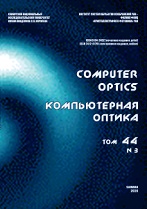|
This article is cited in 12 scientific papers (total in 12 papers)
IMAGE PROCESSING, PATTERN RECOGNITION
The use of reference marks for precise tip positioning in scanning probe microscopy
P. V. Gulyaev
Udmurt Research Center, Ural Branch of the Russian Academy of Sciences, Izhevsk, Russian
Abstract:
The article discusses techniques for the precise positioning of a probe tip on the surface under study in scanning probe microscopy. The precise tip positioning is of high importance when studying the same sample with various microscopes, probes, in various environments and conditions. It is offered that the precise positioning should be done by applying on the surface equidistant reference marks with a nanoindentor along a straight line. The article describes a procedure for shifting the microscope’s field of view for detecting the reference marks and subsequently moving the probe along the marks line. A reference marks recognition algorithm is presented. The algorithm is based on the image correlation analysis using a master mark image and the subsequent extraction of special points (at local maxima of the correlation coefficient). A descriptor of mutual distances between the special points and the Pearson coefficient (аs a quantitative criterion of recognition) are used for recognition. Three types of reference marks are considered: a circle, a circle with gradient filling, and a circle with continuous filling. It is shown that the number of the allocated special points can be significantly larger than that of the reference marks. A method for filtering special points is offered. The method is based on the threshold filtering of special points using values of the correlation coefficient. The filtering consists in excluding those special points in whose neighborhood the difference of the maximum and minimum of the correlation coefficient does not exceed a preset threshold. Results confirming the effectiveness of the offered filtering method are presented. Recommendations for choosing the parameters of the recognition and filtering algorithms are given.
Keywords:
scanning probe microscopy, correlation coefficient, special point, master images, reference mark, recognition.
Received: 27.09.2019
Accepted: 06.11.2019
Citation:
P. V. Gulyaev, “The use of reference marks for precise tip positioning in scanning probe microscopy”, Computer Optics, 44:3 (2020), 420–426
Linking options:
https://www.mathnet.ru/eng/co804 https://www.mathnet.ru/eng/co/v44/i3/p420
|

| Statistics & downloads: |
| Abstract page: | 92 | | Full-text PDF : | 38 | | References: | 8 |
|




 Contact us:
Contact us: Terms of Use
Terms of Use
 Registration to the website
Registration to the website Logotypes
Logotypes








 Citation in format
Citation in format 
